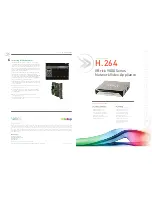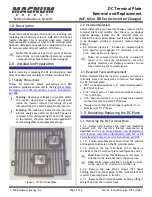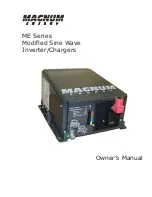
-9-
2.
AC safety Grounding—The AC input ground wire must connect to the incoming ground from
your AC utility source. The AC output ground wire should go to the
grounding point for your loads.
(for example, a distribution panel ground bus)
3.
Neutral Grounding
115V models: The neutral conductor of the AC output circuit of the Inverter is automatically
connected to the safety ground during inverter operation. This conforms to National Electrical
Code safety requirements. For models configured with a transfer relay, when AC utility power is
present and the inverter is in bypass mode, this connection (neutral of the inverter’s AC output to
input ground) is not present so that the utility neutral is only connected to ground at your breaker
panel, as required.
230V models: There is no connection made inside the Inverter from either of the line conductors
(line or neutral) to the earth ground.
PLEASE READ THESE INSTRUCTIONS CAREFULLY BEFORE COMMENCING INSTALLATION
Installation should be performed by competent professional electrical/renewable energy installer, as
dangerous voltages can be present.
Complete the following steps in the order shown:
1.
Mounting
•
Unpack your inverter from its shipping container and inspect the unit for any obvious transit
damage. Report any concerns immediately to your supplier.
•
Mount the inverter to a suitable surface, paying close attention to the mounting requirements
previously mentioned in this manual.
2.
AC Wiring
Important: to satisfy warranty requirements and conditions, a qualified electrician must perform all
AC wiring.
3.
DC Wiring
IT IS ESSENTIAL that the battery bank voltage matched the DC input voltage rating of the
inverter. Damage to the inverter could result from improper voltage connections.
A battery fuse must be installed between the batteries and the inverter; appropriately sized
Motor-starting fuses or similar are recommend.
Before making any connections ensure that the inverter circuit breaker is in the OFF
position. Connect the inverter DC input cables to the battery terminal, the BLACK cable to
the negative battery terminal.
4.
Ground Fault Circuit Interrupters (GFCI’S)
Installations in Recreational Vehicles (for North American approval) will require GFCI protection of
all branch circuits connected to the AC output of the Inverter. In addition, electrical codes require
GFCI protection of certain receptacles in residential installations. While the output of the Inverter
is equivalent to the waveform provided by utilities, compliance with UL standards requires us to
test and recommend specific GFCI’s. State power has tested the following GFCI-protected 15A
receptacles and found that they functioned properly when connected to the output of the Inverter.
WARNING!
Operation of the inverter without a proper ground connection may
result in an electrical safety hazard.
































